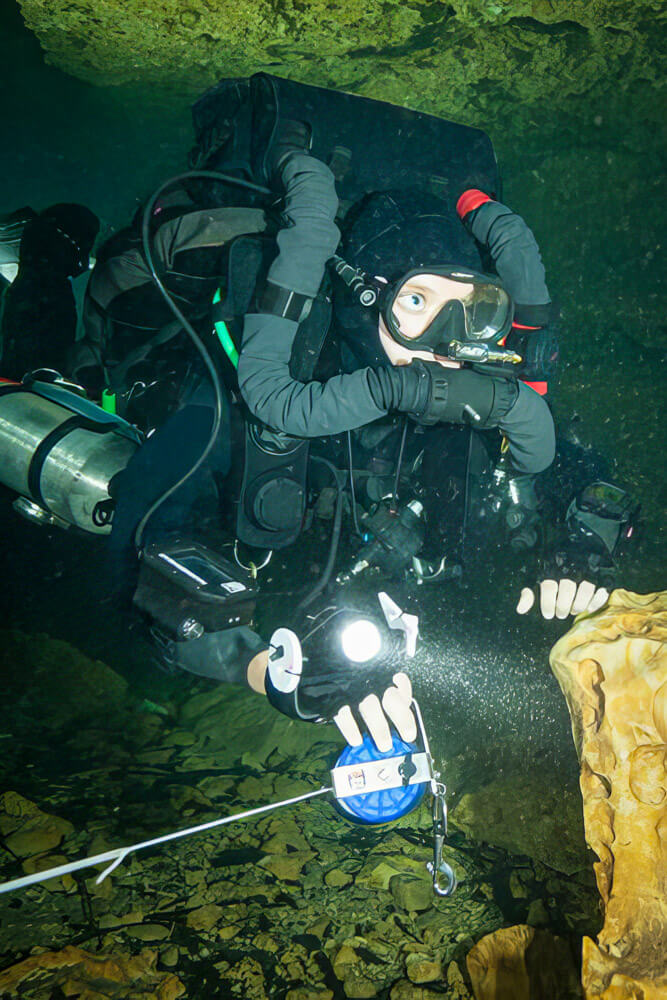Rebreather Full Cave


Are you a Closed Circuit Rebreather (CCR) diver who is a serious adventure seeker wishing to explore overhead environments? Sign up for the TDI Full Cave Diver Course!This course is the third stage of overhead environment training in the series of TDI’s Rebreather Full Cave Diver Development Program. Advanced rebreather cave dive planning, the practical execution of different types of cave systems and scenarios divers encounter are presented. This cave diving course is not intended to prepare divers for evaluating all facets of cave diving. The objective of this course is to expand and critique previous skills accomplished in the TDI Rebreather Cavern and Introductory Cave Diving Programs. Emphasis is placed upon dive planning, bailout range requirements, and skill perfection through actual cave penetration.
Interested?
Who this course is for:
The certified TDI Rebreather Introductory Cave Diver (or equivalent), who has interest in moving forward with overhead environment diving and expanding their diving techniques, capabilities, range, and more!
Course prerequisites:
- Minimum age 18
- Certified TDI CCR Air Diluent Decompression Procedures Diver certification or equivalent
- Provide proof of a minimum of 50 logged dives and 50 hours on the rebreather unit used in training
- Provide proof of certification as a TDI Rebreather Introductory Cave Diver or equivalent
or
- TDI Full Cave Diver or equivalent
What you can expect to learn:
The TDI Rebreather Full Cave Diver Course takes an in-depth look at all of the following and more:
- Policies for rebreather cavern diving
- Psychological considerations
- Equipment considerations
- Bailout cylinder options
- Rebreather configuration options
- Scrubber options
- Buoyancy compensator device (BCD) / harness options
- Reel options
- Proper weighting
- Equipment configurations
- Communication
- Hand signals
- Light signals
- Touch contact signals
- Swimming techniques
- Body posture / trim
- Buoyancy control and rebreather weighting
- Line following techniques
- Propulsion techniques
- Physiology
- Breathing techniques
- Stress management
- Cave environment
- Geology
- Local access requirements
- Land owner relations
- Conservation
- Problem solving
- Equipment failure
- Silting conditions
- Accident analysis
- Review of dive tables and decompression theory
- Cavern diving with Open Circuit (OC) divers
- Bailout configuration requirements
- Out of gas emergencies
- Cavern diving etiquette
Skills you will have to demonstrate:
Some of the required skills you will have to demonstrate include all of the following and more:
- How to properly:
- Deploy a guideline
- Follow a guideline
- Conduct bailout exit including bottle swapping while following a guideline
- Conduct bailout exit including bottle swapping simulating zero visibility and using touch contact while following a guideline
- Use of safety reel in:
- Lost diver procedures
- Lost line drill
- S-drills to be performed on all dives
- Demonstrate adequate pre-dive planning
- Equipment check and equipment matching
- Demonstrate:
- Specialized propulsion techniques in varying types of flow
- Proper buoyancy control, body posture, stress analysis, oxygen partial pressure management, and overall rebreather instruments analysis
- Remove and replace mask while in contact with the guideline
- Demonstrate light / hand signals and touch contact
- Execute conservation and awareness techniques
- Use referencing as back-up navigation
- Demonstrate adequate anti-silting techniques
- Simulate a primary light failure, and use back light to exit the cave
- Demonstrate lost line drills using instrumentation lighting only
- Demonstrate lost diver drills
- Demonstrate to use of reels to perform jumps and gaps required in circuits and traverses to maintain a continuous guideline to open water
- Exit the cave flying the rebreather in SCR mode
- Exit the cave simulating solenoid failure (if applicable)
- Demonstrate advanced navigation techniques including a minimum of:
- 4 jumps
- 2 circuits
- Demonstrate rebreather unit specific skills in compliance with current level of rebreather certification as outlined in the TDI course curriculum
*Note: At NO point during the TDI Rebreather Full Cave Diver Development Program should the diver be unable to monitor their PO2 while on their rebreather. Zero visibility drills must be performed in a realistic way, allowing the student the ability to monitor their handset or heads up display.
What’s in it for you:
Upon successful completion of this course, graduates may engage in single guideline rebreather cave diving activities without direct supervision provided the graduates adhere to the following requirements:
- Diver carries adequate bailout to safely exit from the furthest point of penetration and complete and decompression stops using a minimum SAC rating of 30 litres per minute / 1 cubic foot per minute OR the students calculated elevated SAC rate to account for a CO2 event, whichever is greater
- The diving activities approximate those of training
- Planned dives do not exceed diver’s current certification level
- Diver must maintain a continuous guideline
- Proper cave diving equipment must be used
- Safety and decompression stops as appropriate or necessary
- No equipment removal in cave
Minimum requirements:
- Satisfactorily complete the written examination with an 80% passing grade, followed by 100% remediation by the Instructor
- Perform all land drills and cave dive requirements efficiently
- Demonstrate mature, sound judgment concerning dive planning and execution
- Maintain an appropriate level of awareness and respect for the environment
- Log all training dives